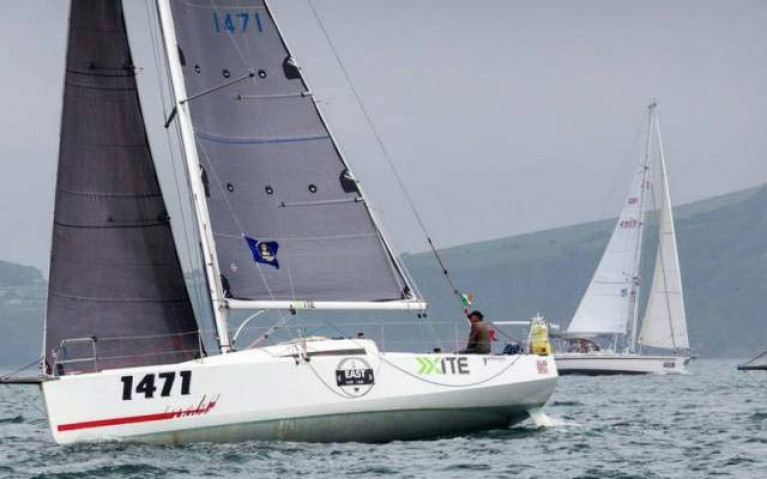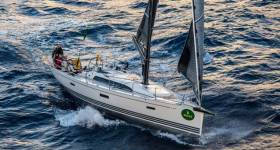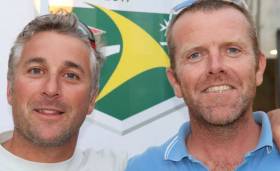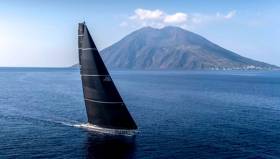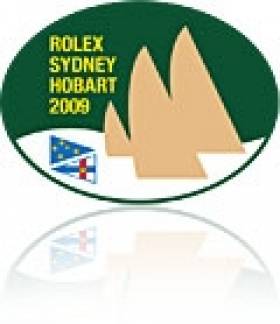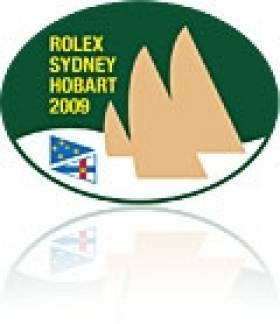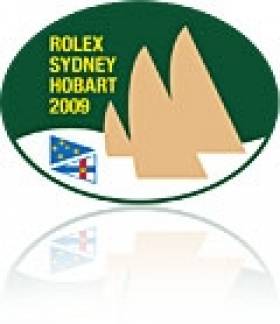Displaying items by tag: Barry Hurley
OSTAR & TWOSTAR Races Get New Date in May 2021
The Royal Western Yacht Club of England has announced the rescheduling of its OSTAR TWOSTAR that was postponed in 2020 due to the COVID 19 virus, to a new date of May 9th 2021.
The 2021 race will continue to run between Plymouth England and Newport Rhode Island as before.
Ireland has previous success in the OSTAR Race through the pioneering efforts of Cork Harbour solo sailor Barry Hurley who took a class win in 2009 and more recently with Howth Yacht Club's Conor Fogerty who raced to success in 2017.
A new 2021 Notice of Race, Entry form and World Sailing 2020 - 2021 Offshore Safety Regulations for Cat 1 yachts can all be downloaded from the event website.
Middle Sea Race Tests JPK 10.80 to Success
If you had to be in a 35-footer as the remaining fleet in the Rolex Middle Sea Race 2017 negotiated those foul gale-and-backwash conditions off the huge cliffs of northwest Sicily earlier this week, then the JPK10.80 would have been the Boat of Choice writes W M Nixon.
For not only does the French wonderboat have a superb performance, but as Paul O’Higgins told us after his JPK 10.80 Rockabill VI had convincingly won the very rugged Dun Laoghaire to Dingle Race in June, when off watch in heavy weather: “You really do get a proper little spell of sleep. To begin with, the boat is so well built there is no water finding its way below. Troublesome drips from above are unknown. You won’t find the sleeping bag is slowly dampening from some hidden little puddle. And within the limits of slugging to windward off Ireland’s south coast, she’s as seakindly as can be, particularly when you have a helmsman of world quality who knows that a banging boat is a slow boat. And always, there’s the reassurance of knowing how well she is built. She’s definitely not going to fall asunder under you and about you. There’s no better recipe for a refreshing sleep when it’s your turn to be off watch”.
Observers have noted that the Russian-owned JPK 10.80 Bogatyr (Igor Rytov) was doing well in class in the Rolex Middle Sea Race 2017. And as her division was Class 6, she was best-placed of those in it still racing to benefit from the fact that the biggies – and George David’s Rambler 88 in particular – had seen the odds pile against them by being stopped in early race calms.
But although Bogatyr has been on the European scene this past season, as she’d been 34th at the rock during the Fastnet Race, and 50th at the finish when sister-ships had shown much better, her chances overall were accordingly discounted.
And as well, even a Mistral-generated bucket of wind isn’t going to last for ever. What chance was there of a 35 footer carrying that glorious fair wind all the way from western Sicily round the islands and into Valetta?
The answer is: A slim chance. But enough. Bogatyr came into Valetta as one of the very few Class 6 boats still racing, and except for one, the others were far away. But the Russian JPK 10.80 had the win of a lifetime by getting a corrected time of just 6 minutes and 29 seconds better than another late challenger, James Blakemore’s Swan 53 Music from South Africa, which pushed last night’s leader Teasing Machine (Eric de Turkheim) into third place.
As suspected in yesterday evening’s report, the Ker 46 Tonnerre de Glen from France had become temporarily mislaid in the official results, but by midnight she’d appeared at second overall. However, that too has gone, as another very gallant Class 6 boat, the Elan 350 Rosatom Sailing team, has nipped into fourth, while the Irish-oriented Xp-44 XP-ACT, with Barry Hurley and Shane Diviney aboard and chasing the bigger Music, has fetched up in fifth with Tonnerre sixth.
About an hour and ten minutes covers the corrected times of the first six boats, and they’re from four different classes, so despite the extreme vagaries of the weather, the IRC seems to have done its work in efficient style.
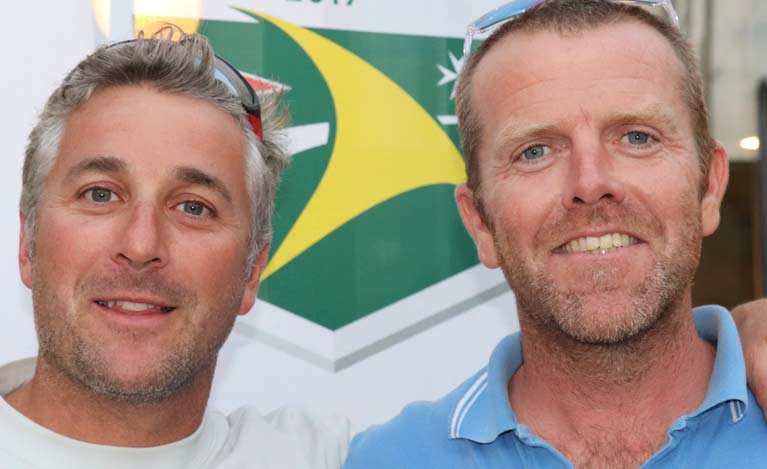 Game over. Nick Jones and Barry Hurley in good form in Valetta after “a lovely race with plenty of breeze”.
Game over. Nick Jones and Barry Hurley in good form in Valetta after “a lovely race with plenty of breeze”.
As to the race, fourteen times Middle Sea veteran Barry Hurley (who had Nick Jones of the all-conquering First 44.7 Lisa in his ship’s company) sums it up with droll exuberance:
“That was a lovely race. We had plenty of breeze but not as much as the fellows back in Ireland had, so all is good. This was my 14th race, and probably three have been as breezy as this in the past. The second half of this race was really fast, it took us half the time to finish the race than 2012. We have a great team, something like 70 races between us, an insane amount of experience, and we have all been able to rely on each other, which is what you want in a crew.”
Results here
Middle Sea Race: Cobh's Barry Hurley Steers Xp-ACT Home as First Maltese Boat to Finish
The first Maltese boat home in the Middle Sea Race was Josef Schultheis and Timmy Camilleri’s Xp-ACT with Ireland's Cork Harbour Sailor Barry Hurley on board, completing the offshore race after just over three and a half days a sea writes Louay Habib. For the sailors of the island state, topping the local fleet ranks just behind the overall race win in terms of achievement.
The rivalry is friendly, but fierce. “It is great to be the first Maltese boat back, a great run round,” commented Camilleri. “
A fantastic race overall in difficult conditions with a great result. I have a fantastic crew, and it is so nice to have such a huge reception in the early hours of the morning.”
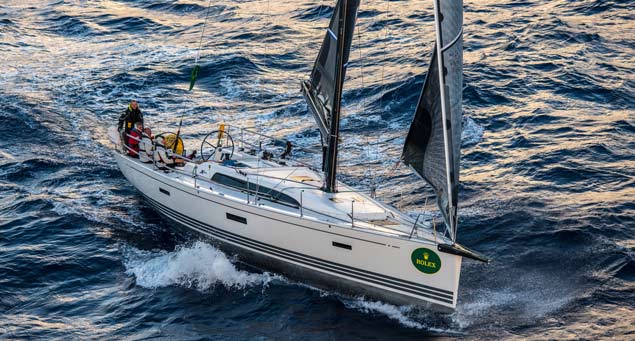 Barry Hurley standing at the back of Xp-ACT, as the yacht passes Favignana. Photo: Kurt Arrigo
Barry Hurley standing at the back of Xp-ACT, as the yacht passes Favignana. Photo: Kurt Arrigo
“That was a lovely race.” joked Hurley. “We had plenty of breeze but not as much as the fellows back in Ireland had, so all is good. This was my 14th race, and probably three have been as breezy as this in the past. The second half of this race was really fast, it took us half time time to finish the race than 2012. We have a great team, something like 70 races between us, an insane amount of experience and we have all been able to rely on each other., which is what you want in a crew.”
Latest: on the morning of the fifth day, some 25 yachts have finished the 2017 Rolex Middle Sea Race. The brutal Mistral-driven conditions have resulted in a high attrition rate with 60 of the 104 yachts now officially retired. 19 yachts are still racing.
Eric de Turckheim's 54-foot Teasing Machine, the French Nivelt Muratt design, arrived back in Malta just after midday on Day Four, and initially headed the leaderboard both in class, IRC Two, and overall. With rival teams still racing, the French team could do no more and relaxed at the Royal Malta Yacht Club, waiting for the race to unfold further. “This is the first time we have raced the new Teasing Machine, and we are very happy,” remarked de Turckheim, whose talented crew includes Volvo Ocean Race winner Laurent Pages. “The race was a great test in light and heavy conditions and the crew and the boat performed extremely well.”
Also back in port, in IRC Two, is Anthony Leighs’ Elliott 35 Crusader; a remarkable achievement for a 10.5 metre yacht. She is likely to be the smallest boat to finish the race this year. The Kiwi crew’s amazing tenacity and handling skills look likely to claim a podium position in class.
Dominique Tian's Ker 46 Tonnerre de Glen appears to have won IRC Three. The French team are all from Marseille and for long periods of the race Tonnerre was in the hunt for the overall win. Gear failure would eventually put paid to their assault. “This is why I love offshore racing,” commented Tian after finishing the race. This course is a beauty and a beast. The experience is full of fantastic memories but, unfortunately, we broke our boom near Lampedusa. We had to lower the main, and hoist the storm trysail.”
At Lampedusa, James Blakemore's Swan 53, Music, could sense the possibility of overall victory. According to the race tracker, the South African team had been trading blows at the top of the leaderboard since Messina. The last long leg back to Malta would be a final all-out push. “We did the race four years ago, at the first waypoint we were leading. We were 76th at the next! This was unfinished business for us. I like Malta and I love this race; it is a fantastic course and it is a well-supported event,” said Blakemore, shortly after stepping ashore. “Music is a magnificent seaworthy boat. We picked up 45 knots in a squall near Lampedusa, the rain came down and it was surreal. We ran down with it for ten minutes, banged about a bit and got a look at our keel, but we knew she would handle it!”
Blakemore is full of praise for his crew. The boat is just the vessel. It takes human skill and resilience to get it around the course fast and safe. “The crew have been outstanding,” he advised. “I have seven heroes. Mike Giles my crew boss is a spectacular individual. Gerry Hegie, the Boat Captain, is a man mountain. He will sit at the wheel in the roughest weather for six hours without a problem. For the young Cape Town boys on board, they have been given a great opportunity to come and sail, and they have taken it with both hands. The crew have really been single-minded about concentrating on the race and getting the boat round.”
The first Maltese boat home was Josef Schultheis’ and Timmy Camilleri’s Xp-ACT, completing the race after just over three and a half days at sea. For the sailors of the island state, topping the local fleet ranks just behind the overall race win in terms of achievement. The rivalry is friendly, but fierce. “It is great to be the first Maltese boat back, a great run round,” commented Camilleri. “A fantastic race overall in difficult conditions with a great result. I have a fantastic crew, and it is so nice to have such a huge reception in the early hours of the morning.”
Camilleri’s co-skipper, Schultheis, was just as effusive: “That was a tough one with a great crew and we are better friends now for sure. I will always remember smoking downhill with our kite flying doing 18 knots through the fairway buoy outside [Marsamxett] harbour. It was a thrilling moment.”
The Podesta family racing Maltese First 45 Elusive 2, finished third in class and currently lie eighth overall. The Podesta siblings have shown previously their determination in the face of gale force winds. Skippered by their late father Arthur, they completed the storm-ridden 2007 race. The experience and lessons learnt would have stood them in good stead this year.
At 03.33 CEST this morning, Wednesday 25 October, there was another change at the top of the leaderboard. Igor Rytov's Russian JPK 1080 Bogatyr crossed the finish line and slipped to the top of the overall standing. Bogatyr had been pursuing Music hard throughout the race. The tracker showed a slim 15 second margin at Lampedusa. By the finish, the Russian crew had built an advantage of 6 minutes and 29 seconds. With only 19 boats left to finish a major achievement is on the card for Rytov’s crew.
Middle Sea Race: Hugo Boss Makes Superb Work of Tricky Conditions, Rambler Recovers From Being Stuck at Stromboli
Everyone going into the 608-mile Rolex Middle Sea Race knows they will experience a challenging course with weather which can be anything and everything from extended calms to surprisingly vicious gales, and the 2017 edition is no exception writes W M Nixon
In mostly light easterly winds after the start on Saturday, the fleet’s stately progress saw George David’s Rambler 88 give a master-class in taking full advantage of every new if small improvement in wind strength, and she lengthened away from the likes of the 100ft Leopard and the 98ft CQS in impressive style, only to see it evaporate again as she was invariably the first one into the next belt of calm.
However, she was always in the lead, and was on the up and up approaching Stromboli yesterday, only to find things very flat beyond that splendid turning point. Increasing desperate to find breeze anywhere, and always looking to be first into the much-forecast strong to gale west to norwest wind which was expected last night, she crawled along at barely a knot and ended out somewhere about nor’nor’east of Stromboli, taking a very wide turn before she began to feel the first of a new air. This eventually became the breeze which gave her a long tack/short tack beat to the next turn at the island of Favignana west of Sicily’s most westerly headland.
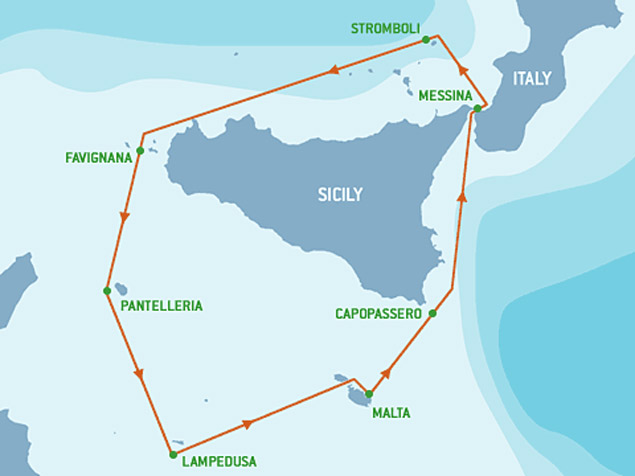 The 608-mile Rolex Middle Sea Race has a bit of everything – and sometimes a lot of wind. Rambler is now on the Pantelleria-Lampedusa stage, tearing along at up to 26 knots in a mighty west to northwest wind.
The 608-mile Rolex Middle Sea Race has a bit of everything – and sometimes a lot of wind. Rambler is now on the Pantelleria-Lampedusa stage, tearing along at up to 26 knots in a mighty west to northwest wind.
It was the IMOCA 60 Hugo Boss (Alex Thompson & Nin O’Leary) which went most determinedly to the northwest. They’d actually arrived at Stromboli at a time when a neat rounding had become possible, but knowing their very special boat’s notable lack of enthusiasm for tacking duels and windward work generally, they slugged on for many miles on port tack until they could hope to lay Favignana without having to tack again.
It was a tactic which worked a treat, and now while the bulk of the fleet are still bashing it out in rugged weather north of Sicily, Hugo Boss is screaming along at 24 knots and more from Favignana towards the next turn at Pantellaria, third on the water to Leopard which is slower at 22 knots, while Rambler is already past Pantellaria and making 26 knots for Lampedusa, the final turn before the finish at Valetta.
The speeds being achieved by the three leaders could well invert the leaderboard’s former emphasis in smaller craft, which still have an awful lot of hard sailing to Favignana before they can let rip. Otra Vez (Brian Flahive & Sean Arrigo) had been well placed in the two-handed division, but now seems to signal retirement, however Xp-ACT with Barry Hurley and Shane Diviney in her crew is well-placed for the Favignana rounding, while Conor Doyle’s chartered Hydra has also made good progress along Sicily’s north coast.
But having seen small boats dominate the top placings early on, we now have the fascinating prospect of the three leading biggies carrying the strong favourable winds all the way to the finish at enormous speeds, and turning the results upside down.
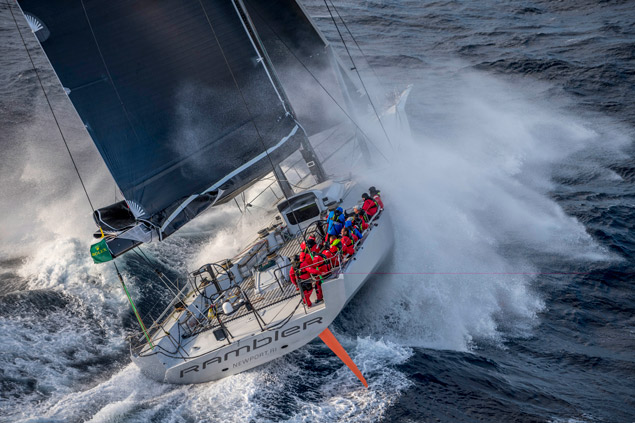 Here we go……Rambler starts to free off as she weathers Favignana at eight o’clock this morning. Photo: Kurt Arrigo
Here we go……Rambler starts to free off as she weathers Favignana at eight o’clock this morning. Photo: Kurt Arrigo
Tracker here
Ireland Hit The High Spot In The Sydney Hobart Race 23 Years Ago
#rshyr – Ireland's fascination with the Rolex Sydney-Hobart Race moved onto a new plane in 1991, when a three-boat Irish team team of all the talents had a runaway win in the Southern Cross Series which culminated with the 628-mile race to Hobart. The three skipper/helmsmen who led the squad to this famous victory twenty-three years ago were Harold Cudmore, Joe English and Gordon Maguire, all on top of their game.
These days, the incomparable Harold Cudmore is still a sailing legend, though mostly renowned now for his exceptional ability to get maximum performance out of large classics such as the 19 Metre Mariquita, sailing mainly in European waters.
But sadly, Joe English passed away just eight weeks ago in November in Cork, much mourned by many friends worldwide. Yet for Gordon Maguire, the experience of sailing at the top level in Australia was life-changing. He took to Australia in a big way, and Australia took to him as he built a professional sailing career. And he's still at it in the offshore racing game as keenly as ever, with 19 Sydney-Hobarts now logged, including two overall wins.
He raced the challenging course of this 70th 2014 edition as sailing master of the Carkeek 60 Ichi Ban, a boat which is still only 15 months old, having made a promising though not stellar debut in 2013's race. Also making a determined challenge was the First 40 Breakthrough with a strong Irish element in the crew led by Barry Hurley, fresh from the class win and second overall in October's Rolex Midde Sea Race.
And high profile Irish interest was also to be found aboard the Botin 65 Caro, the record breaker in the 2013 ARC Transatlantic Race. She's a very advanced German-built "racer/cruiser" aboard which Ian Moore - originally of Carrickfergus but longtime Solent-side resident - was sailing as navigator.
W M Nixon casts an eye back over the 2014 race, whose prize-giving took place in Hobart yesterday, and then concludes by taking us back to 1991, when Ireland moved top of the league in the Offshore Racing World Team Championship on the same occasion some 23 years ago.
It has to have been the most keenly-anticipated debut in recent world sailing at the top level. At last we'd get to see how Comanche could go in serious sailing. When the 70th 628-mile Rolex Sydney-Hobart Race started on Friday December 26th at 0200 hours our time, 1300 hrs local time in Sydney Harbour, this was for real. There may have been 117 boats of all shapes and sizes from 33ft to 100ft in the fleet. But all eyes were on the limit-pushing 100ft Comanche, skippered by the great Kenny Read. The world wanted to see how she would show what she could do when the chips were down, when the racing was straight line stuff, and when some serious offshore battling was in prospect instead of the inshore-hopping mini-test which had been seen in the Solas Big Boat Challenge in Sydney Harbour on December 9th.
In that, the well-tested Wild Oats XI, skippered by Mark Richards, had sailed a canny race to take the line honours win from the other hundred footers. But the majestic Comanche, owned by Jim Clark and his Australian wife Kristy Hinze Clark, had shown enough bursts of speed potential to raise the temperature as the start of the big one itself approached.
And in a brisk southerly at the start, Comanche didn't disappoint. She just zapped away from Wild Oats to lead by a clear 30 seconds and notch a record time at the first turning mark to take the fleet out of Sydney Harbour, and that dream debut was what made the instant headlines on the beginning of the 628–mile slog to Hobart.
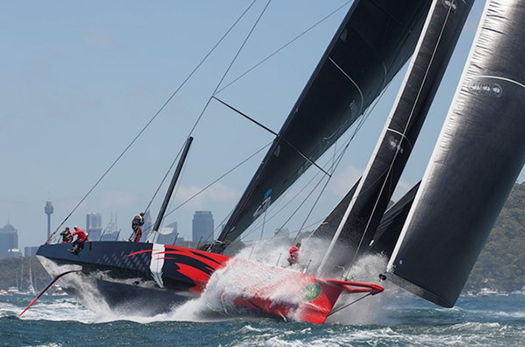
The moment of glory – the mighty Comanche roaring down Sydney Hobart at the start to log a record time to the first turning mark. Photo: Rolex/Daniel Forster
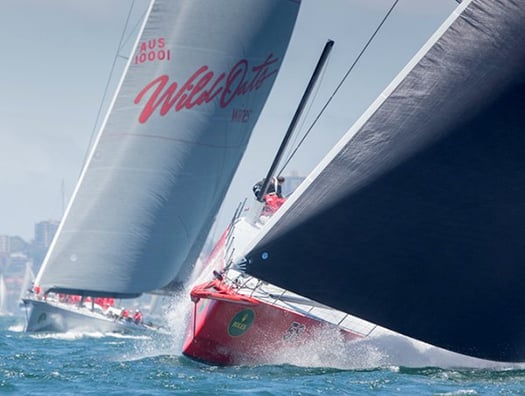
No two ways about it – Comanche is clear ahead of Wild Oats XI approaching the first mark. Photo: Rolex/Daniel Forster
But out at sea, with winds strengths varying but mostly from the south for the first day or so, different stories begin to emerge. A grand sunny southerly sailing breeze may provide lovely sailing and pure spectacle in Sydney Harbour. But get out into the Tasman Sea to head south for Hobart, and you find that the wayward south-going current – always a crucial factor in the early stages of the race to Hobart – can be going great guns and making mischief as a weather-going stream, kicking up a steep sea which can be boat-breaking when that last ounce of performance is being squeezed out.
And as previewed here on December 20th, up among the hundred-footers they've been pushing the envelope and then some in boat development and modification. In new boat terms, the mighty and notably beamy Comanche has gone about as far as they can go for now. But with the likes of the former Lahana reappearing as Rio 100 with a complete new rear half, and Syd Fischer's Ragamuffin 100 simply cutting away the hull for replacement with a complete new body unit while retaining the proven deck and rig, we're sailing right on the edge in terms of what the weird mixtures of new and old build can combine for combat when the seas are steep.
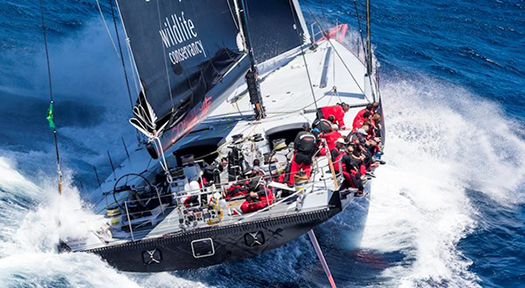
Comanche's wide beam gives added power when there's plenty of breeze......Photo: Rolex/Carlo Borlenghi
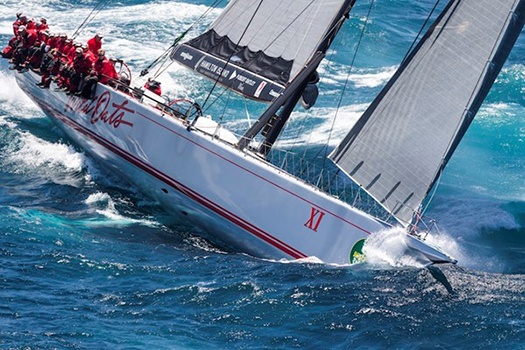
....but the narrow Wild Oats XI can be as slippery as an eel when the head seas get awkward, and when the wind eased she got through Comanche and into an extraordinary 40 mile lead on the water. Photo: Rolex/Carlo Borlenghi
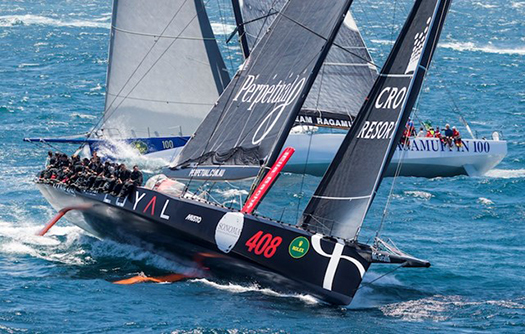
Not all boats revelled in the bone-shaking conditions of the first hundred miles of beating. Perpetual Loyal (foreground) had to pull out with hull damage possibly caused by an object in the water, but the irrepressible Syd Fischer's Ragamuffin 100 (beyond), with a completely new hull, continued going strong to the finish and was third in line honours Photo: Rolex/Carlo Borlenghi
But this glorious element of larger-than-life characters with boats that are off-the-wall is now an integral part of the RSHYR, which manages to attract an enormous amount of attention thanks to its placing in the midst of the dead of winter in the Northern Hemisphere, while in Australia much attention focuses on what is in effect an entire and familiar maritime community racing annually for the overall handicap prize.
Yet though the course is simple, it's deceptively so. Just because it's mainly a straight line from one harbour to another doesn't mean there aren't a zillion factors in play. And as the race gets so much attention, few offshore events of this length are so minutely analysed, and the first 24 hours provided a veritable laboratory for seeing the ways different boats behave in different wind and sea states with the breeze on the nose.
Thus Wild Oats XI has always had a formidable reputation for wiggling her exceptionally narrow hull to windward in awkward seas for all the world like a giant eel, and the early beating saw her doing that very thing, hanging in there neck and neck with Comanche. Despite her beamier hull, Comanche rates slightly lower than Wild Oats. But if a lull with its leftover sea arrived, her greater volume would become a liability to performance, whereas if the breeze got back to full strength, and particularly if it freed the two leaders, then Comanche would be firmly back in business.
But it was not be. Crossing the Bass Strait with Wild Oats right beside them, Comanche's crew saw their navigator Stan Honey emerge on deck and approach Kenny Read with a thoughtful expression on his face, and an ominous little slip of paper in his hand. It was the latest weather print-out, and it wasn't happy reading for a big wide boat that needs power in the breeze. Before expected brisk winds from the north set in, they'd to get through the lighter winds of an unexpectedly large and developing ridge.
Almost while they were still digesting this bit of bad news, Wild Oats started to cope much better with the lumpy leftover sea, and wriggled ahead of Comanche in her classic style. And the further she got ahead, the sooner she got into increasingly favourable wind pressure. As Read put it after the finish: "For twelve hours, conditions were perfect for Wild Oats, and they played a brilliant hand brilliantly".
Amazingly, the old Australian silver arrow opened out a clear lead of an incredible forty miles before conditions started to suit Comanche enough to start nibbling at this remarkable new margin. And fair play to the Read crew, at the finish they'd made such a comeback that Wild Oats was only something like 49 minutes ahead. But even with the new American boat's slightly lower rating, she was beaten on handicap too, and in the final rankings Wild Oats showed up as having line honours overall and a commendable 5th on IRC in Division 0 - and we shouldn't forget she won the overall handicap honours back in 2012 anyway.
But for 2014's race, for a while it looked as if it might be the Cookson 50s again for the overall win. But although last year's Tattersall's Cup winner, the Cookson 50 Victoire, at first took the Division 0 win with her sister-ship Pretty Fly III second, they were so close that when Pretty Fly got 13 minutes redress for an incident with the Ker 46 Patrice in mid-race, it reversed their placings.

It all came good in the end....after being initially placed second in Division 0, the ten-year-old Cookson 50 Pretty Fly III got 13 minutes of redress for an adverse incident during the race, and that bumped her up to the Division 0 win.
Either way, it was still Cookson 50s imprinted all over the sharp end of Division 0. But they were slipping in the overall rankings, where it was boats in the 40-45ft range which were settling into the best combination of timing and conditions to take the Tattersall's.
And plumb in the middle of them was the First 40 Breakthrough, with her strong Dublin Bay Sailing Club input from the Irish team led by Barry Hurley. Fortunes wax and wane with astonishing volatility as the Hobart race progresses, but gradually a pattern emerges. So though at one stage Breakthrough was showing up only around 30th overall, equally she'd a best show of third.
And all around her on the water were similarly-sized and similarly-rated boats with their race-hardened crews knowing that with every mile sailed and every weather forecast now fallen favourably into place, things were looking better and better for this group to provide the overall winner.
It was a very race-hardened crew which came out on top. It was way back in 1993 that Roger Hickman got his first Sydney Hobart Race overall win in an eight year old Farr 43 which was still called Wild Oats, as original owner Bob Oatley hadn't yet reclaimed the name for ever bigger Grand Prix racers. When he did start to go down that road, the 1985 Wild Oats became Wild Rose, but "Hicko" still owns her. And by the time the Rolex Sydney-Hobart Race 2014 started, he was doing it for the 38th time. He went into it as current Australian Offshore Champion, now he has won the big one on top of all that. Some man, some boat.
The slightly higher-rated Breakthrough was pacing with Wild Oats for much of the race, but as Barry Hurley's report for Afloat.ie told us with brutal honesty, somewhere some time they got off the pace. If you didn't know already of Barry's remarkable achievements - which include a class win in the single-handed Transatlantic Race and the more recent Middle Sea Race success – you would warm to the man anyway for the frankness of his initial analysis of why Breakthrough slipped from being a contender to 12th overall and – more painfully – down to 7th in their class of IRC Division 3.
He promises us more detailed thoughts on it in a few weeks time, something which will be of real value to everyone who races offshore, for the race to Hobart is a superb performance laboratory. And maybe we can also hope in due course for further thoughts from someone on whether or not Matt Allen's Carkeek 60 Ichi Ban, skippered by Gordon Maguire with Adrienne Cahalan as navigator, has what it takes to be a killer.
It's easy for us here in Ireland to look at screens of photos and figures and reckon that Ichi Ban is just a little bit too plump for her own good. But Maguire has twice been key to a Sydney-Hobart overall win, the most recent being in 2011 with Stephen Ainsworth's Loki. And Cahalan's record of success as a navigator/tactician is almost without parallel. Yet though Ichi Ban's 2014 Hobart race score of 8th in line honours and fourth in IRC Division 0 is a thoroughly competent result, it just lacks that little bit of stardust.
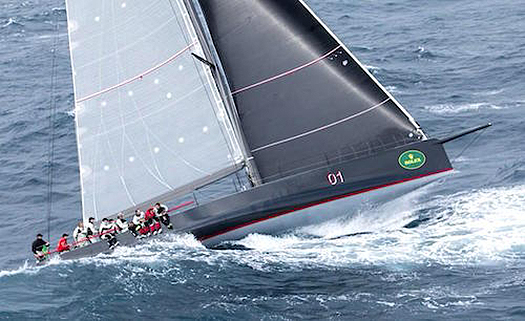
Ichi Ban finding her way through the waves on her way to Hobart. If that's not a spare tyre around her midriff, then what is it?
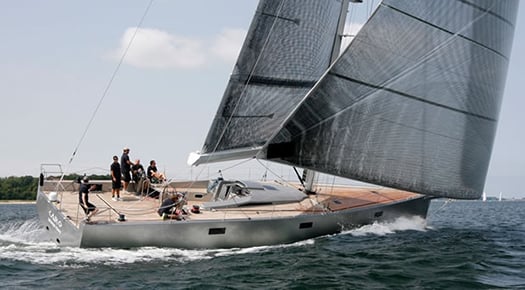
Despite being a "racer/cruiser", the Botin 65 Caro – navigated by Ian Moore – pipped Ichi Ban for third in class.
With the next Rolex Sydney-Hobart Race just over eleven months down the line, let's hope we're proven utterly wrong within the year on the Ichi Ban question. But the whole matter is pointed up by the fact that the boat which pipped in ahead of her in the IRC Div 0 placings in third place behind the two Cookson 50s was the Botin 65 Caro, with our own own Ian Moore navigating on this 65 footer which likes to emphasize her dual role as a racer-cruiser.
Now there really is food for thought. But in this first weekend of this wonderful new year of 2015, let's remember some of the events of December 1991 as recorded in excited detail in the Afloat magazine of Feb/March 1992.
On the cover is Meath-born John Storey's Sydney-based Farr 44 Atara, around which the Irish Southern Cross team of 1991 was built, as Harold Cudmore was aboard, and he brought out John Mulcahy from Kinsale and John Murphy from Crosshaven.
The small boat of the team was Tony Dunne's Davidson 36 Extension – the owner claimed Irishness through the Irish granny rule, but the matter was put beyond any doubt by Joe English being on board with Dan O'Grady and Conor O'Neill. And then for the third boat they'd Warren John's Davidson 40 Beyond Thunderdome, whose owner was happy to be Irish if they'd let him, and to put the matter beyond doubt his vessel was over-run by Howth men in the form of Gordon Maguire, Kieran Jameson, and Roger Cagney, with Dun Laoghaire's Mike O'Donnell allowed on board too, provided he behaved himself.

In the Southern Cross Series of 1991, the Davidson 40 Beyond Thunderdome was raced for Ireland by Gordon Maguire and Kieran Jameson. Thunderdome was top of the points table when she was knocked out with a dismasting in the final inshore race, and was unable to race to Hobart.
It was an accident-prone series, with Beyond Thunderdome dismasted in a tacking collision with one of the Australian boats with just three days to go to the start of the Hobart Race. There simply wasn't time to get a replacement mast, let alone tune it, but at the last minute the jury decided the Australian boat was at fault, and allowed Beyond Thunderdome average points not only for that race in which she'd been dismasted, but also for the Hobart Race which hadn't even yet been sailed.
In a final marvellous twist to the story, as Thunderdome couldn't race to Hobart, Gordon Maguire was drafted aboard Atara to add helming strength for the big one. Atara had only been a so-so performer until the big race. But Cudmore and Maguire – that really was the dream team. And it gave the dream result. Atara won the 1991 Sydney-Hobart race overall by a margin of one minute and 50 seconds. It was one of the closest results ever, but it was a close shave in the right direction for Ireland. The Irish party in Hobart to welcome 1992 was epic. And Gordon Maguire's sailing career was set on a stellar course.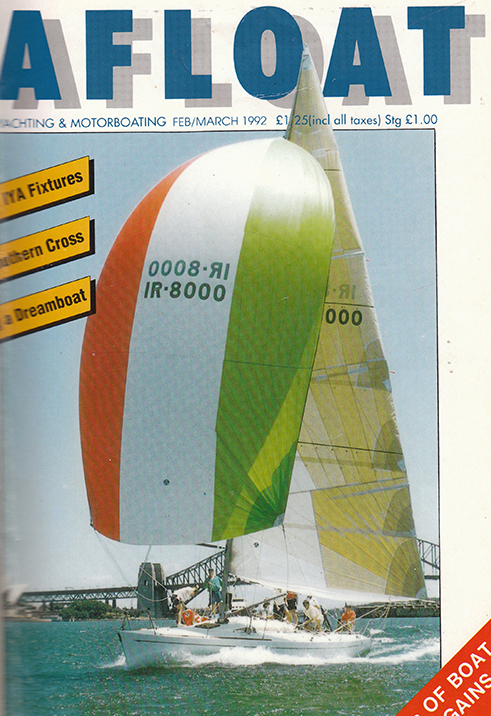
Our magazine edition of February/March 1992 cover-featured John Storey's Farr 44 Atara, overall winner of the 1991 Sydney-Hobart race with the dream team of Harold Cudmore and Gordon Maguire on board to give Ireland the win in the Southern Cross Series.
#rshyr – 11th overall (moving up two places from yesterday's provisional results) Is the best result yet for Irish sailor Barry Hurley in the Sydney Hobart Race. Here, Hurley reviews his performance for Afloat.ie readers
Well, another Sydney Hobart Race successfully finished. That's my fourth time finishing the race, and the third in a row on Breakthrough now.
[Read yesterday's Breakthrough race update here]
On the good side we had a really great race, the boat and sails held up well, and the crew dynamic made for a great atmosphere on board even through the tougher conditions.
Eleventh overall is my best result to date, but I have to admit that seventh in class is slightly disappointing.
It's obvious from the regular position reports when we lost time on the race course, but honestly I'm not sure yet exactly why we lost so much when we did. We did drop down to a slightly smaller kite for a while in the bigger seas, but I wouldn't have expected to lose so much ground. I'm not sure if we were just slow for a while, or we missed a shift, or perhaps we picked up some adverse current. There are certainly some learnings to be taken but there will be plenty time for that.
Over the next few weeks I'll study the tracker logs to figure out exactly what happened. It's somewhat comforting to see that over the last 24hrs of the race we were able to pull back places. The crew really dug deep to push hard in big wind when boats around us were throttling back. Perhaps we shouldn't be disappointed and should be content with a solid overall result against some of the best offshore sailors in the world.
Having just woken up the morning after a late finish last night we've just started to prepare the boat for the return trip. Next week back in Sydney we'll have time to relax sore muscles and review the race properly with all the facts to hand. In the meantime we'll enjoy the atmosphere and New Years celebrations here in Hobart.
It's a fantastic race which is always challenging. Our crew performed brilliantly, and the boat held up well. We all really enjoyed the race and hopefully we'll have an opportunity to come back and try again soon. I'm privileged to be part of such campaigns and to spend so much time offshore with some of my best friends.
We're all extremely proud to fly the flag for Ireland in these events and grateful for all the support from back home.
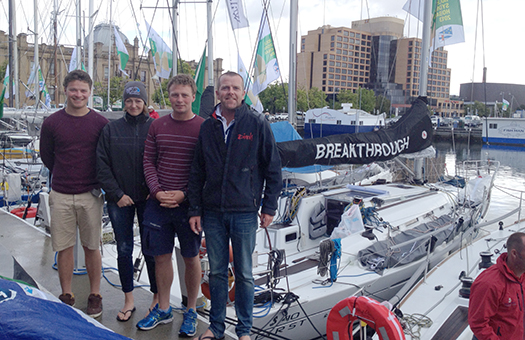
Read all Afloat's Sydney Hobart race updates here in one handy link plus WM Nixon's 2014 Race preview here
11th Place Finish For Ireland's Sydney–Hobart Crew
#rshyr – Ireland's Breakthrough crew led by Barry Hurley has recovered from a lowly 25th place yesterday to finish 11th on IRC overall and seventh in class on day four of Australia's classic Sydney–Hobart race where the overall winner could still be at sea.
Only two hours before the finish the official tracker gave Breakthrough's position in the top ten overall but Constitution Dock, Hobart is buzzing with activity after a stream of boats crossed the finish line throughout Day 4 making any final overall result some time away yet.
Crossing the Tasmanian finish line in Hurley's third succesive race, the Cork Harbour sailor eclipsed last year's result of 27th overall but was a place behind the sixth place in IRC Division 3 achieved in 2013. It was a terrfic recovery over the past 24 hours when Breakthrough had slumped to 27th. Provisional race rankings here
In a race of snakes and ladders, the Irish crewed boat was only an estimated two hours off the overall handicap lead at the halfway stage of the 635–miler. In a fantastic opening peformance the New South Wales entry from Jonathan Stone and Mathew Vadas was as high as third place in the 109–boat fleet.
But after passing Gabo Island, things took a so far unexplained turn for the worse. The First 40 nose–dived down the rankings sinking at one stage yesterday to 27th overall on IRC overall with just 200 miles to the Tasmanian finish line.
Battling strong winds in the Bass Straits to recover some 16 places and seventh in division 3 was never going to be an easy proposition.
The drop in performance – an estimated 1.5 knots off the pace all day yesterday – prompted some of Breakthrough's shore crew to speculate that a torn spinnaker might be to blame. Others said the easterly course chosen by Breakthrough might have contributed to a slower wind angle.
But whatever the reason, the Hurely crew dug deep in the closing stages to haul back in near small boat rivals and take the best result to date in what has been an intriguing and record breaking 70th edition of the Australian classic.
Before the race started Hurley wrote on Afloat.ie 'Being one of the smaller boats at just 40ft, our position in the overall standings will be somewhat a result of the weather patterns during that particular week, whereas our placing within our class will be a true measure of success'. How right he was.
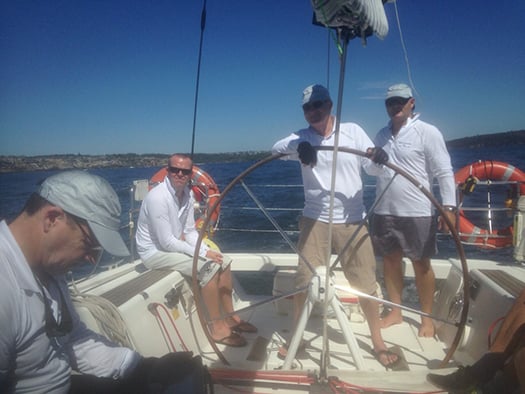
The Breakthrough crew depart Sydney
By 17:00 AEDT, 39 yachts had completed the 628-nm race, as the docks filled with tales from another dramatic contest. Of the 117 starters, 65 yachts are still sailing and a further 13 officially retired, unable to complete the course.
Veteran victory?
Current forecasts have four veteran yachts – Love & War, Quickpoint Azzurro, Wild Rose and the fleet's smallest and oldest boat Maluka of Kermandie – all in contention for overall victory. All three boats represent vast contrasts to the sleek, carbon fibre-built 100-foot Maxis which dominated the race for line honours.
Simon Kurts' Love & War is a three-time winner of the race (1974, 1978, 2006). The boat, built over forty years ago, needs to arrive in Hobart before midnight this evening to retain any chance of claiming an unprecedented fourth Tattersall's Cup. This wooden classic won in two contrasting eras of ocean racing underlining the boat's durability and the true spirit of the Rolex Sydney Hobart: any crew stands a chance of victory provided they demonstrate true teamwork, tactical nous and an intrepid spirit. Love & War, featuring veteran navigator Lindsay May competing in the race for a staggering 41st time, is currently approximately 40-nm from the finish.
Roger Hickman's Farr 43 Wild Rose is a mere 29 years old and pushing hard for that elusive first Tattersall's Cup. In poignant synergy, Wild Rose was once owned by Wild Oats XI's Bob Oatley, whose crew yesterday claimed a record-breaking eighth line honours victory. Wild Rose has already produced a stern, resilient performance, overcoming adversity on her journey south. "We had a massive broach in 30 knots this morning with the spinnaker up," Jenifer Wells, the crew's navigator reported. "We laid her over a couple of times, broke the steering cable and it was looking very dicey. "We got out the emergency tiller and pulled the kite down, repaired the cable and we were back racing in 12 minutes."
Another wooden classic is Maluka of Kermandie, a gaff-rigged huon pine beauty. Owned by one of the race's colourful characters, Sean Langman, the 30-footer still lies some 122-nm from the finish line.
Currently leading on handicap though is Shane Kearns' Sparkman & Stephens 34 Quickpoint Azzurro 108-nm from Hobart.
Happy Hobart
The crews arriving in Hobart this afternoon carried the look of seasoned offshore racers: tired, proud, red-eyed, salty and wind-swept.
"The race is always very different and always extremely challenging and this one was special as it was my wife's first Rolex Sydney Hobart," explained Philip Coombs, owner of the 42-ft Simply Fun, whose amateur crew performed miracles to even make the start line. "The team I have are brilliant. Three days before we were due to leave for Sydney our boat had extensive damage so the boat builders worked night and day for two weeks to get us ready. We are happy to be here considering all of the factors involved."
Mark Covell on the British-flagged Swan 68, Titania of Cowes, reported: "It was an absolute classic, starting off on the nose, plenty of rail time, lots of waves over the boat, before it slowly lightened up. We then got kite up and breeze kept coming up and up; we ended coming up the Derwent (River) on the nose in a hailstorm. We pretty much had everything!"
Reflective glory
Shortly after lunchtime on Day 3, Bob Oatley's Wild Oats XI claimed her eighth Rolex Sydney Hobart line honours victory in ten years. This morning skipper Mark Richards was able to reflect on a momentous achievement for the 100-foot Maxi. "An eighth Rolex Sydney Hobart line honours win is something we never would have dreamt about ten years ago. The reception from hundreds of spectator boats and tens of thousands of people on the dock is a spectacular way to finish a yacht race."
That high level of interest continues as the sailing world stands by to learn the identity of the 2014 overall winner.
Irish Crew Vying for Overall Sydney–Hobart Lead
#rshyr – Irish crewed yacht Breakthrough is an estimated two hours off the overall handicap lead at the halfway stage of the 635–mile Sydney–Hobart yacht Race. Lead by top Irish offshore sailor Barry Hurley, the New South Wales entry from Jonathan Stone and Mathew Vadas is lying 33nm SE of Gabo Island in third place in the 109–boat fleet. After its second night at sea Breakthrough has still to sail 382.5 miles to the Tasmanian finish.
Hurley has on board Dublin Bay sailors Alexander and Kenneth Rumball and Catherine Halpin along with a local Sydney crew. The Aussie–Irish team are currently behind Roger Hickman's Wild Rose and Ron Foster's Ariel on IRC handicap.
Prior to his departure Hurley wrote about preparations for his third successive Sydney–Hobart race.
Irish 'Breakthrough' Sailors Set For Sydney–Hobart Challenge
#rshyr – With less than 24 hours left to the start of the 70th edition of the Rolex Sydney to Hobart Race, Irish sailors, Barry Hurley, Catherine Halpin, Alexander and Kenneth Rumball sailing aboard the First 40 BREAKTHROUGH are completing some last minute touches prior to the start writes Kenny Rumball. The rest of the crew on the boat consist mainly of Australians with Matthew Vadas (skipper), Ben Hunter, Jonny Hoover, Adam Carpenter and Peter Thorp completing the 10 strong team.
The First 40 has undergone an extensive programme in preparation with new standing rigging, a largely new sail wardrobe and other essentials with Barry overseeing many of the upgrades throughout the year. The Australian crew have worked hard to tune the boat up in the Cruising Yacht Club of Australia Blue Water Points Score with the Sydney to Hobart being the last race in the series. Breakthrough have performed well in the series and currently stand 8th in the series and scoring a 4th place in the last race.
With the initial forecast giving 25-30kts for the first 24 hours after the start, the crew will have to work hard through the first night going down the eastern shoreline. The east Australian current will give the fleet a nice help along as they race south. The wind should hopefully swing into the north after day 1 allowing the teams to crack sails and raise spinnakers as they enter the Bass Straits. The infamous stretch of water between the south coast of Australia and Tasmania usually serves up a good test of man and ship with a large oceanic swell and some good breeze.
The 'organ pipes' on the south eastern coastline of the island of Tasmania will be a welcome sight for the tired sailors before the sail through storm bay passing the iron pot at the mouth of the Derwent river leading up to Hobart.
Irish Crews Among Small Boat Sailors Boosted By Sydney-Hobart Race Weather Forecast
#rshyr – In Sydney, forecasters have revealed that a southerly breeze will play in to the hands of smaller boats – including a number of Irish sailors – for Australia's 70th Rolex Sydney Hobart race that starts on St. Stephen's Day.
Irish crews competing in four days time include Sydney–based Gordon Maguire, orginally from Howth Yacht Club racing on the front–runner Carkeek 60, Ichi Ban. And as Afloat.ie previously reported, Barry Hurley of Cork Harbour and the Royal Irish Yacht Club leads a part Irish crew on the First 40 Breakthrough with Irish National Sailing School brothers Kenneth and Alexander Rumball and Dublin Bay sailor Catherine Halpin on board. Hurley, a Middle Sea Race Winner from October, gave an account of his Sydney–Hobart preparations here.
Locally based Irish sailor Keith Hegarty is racing his first Sydney-Hobart on Merlin, a Kaiko 51, owned and skippered by 81–year–old David Forbes, a legend in Australian sailing with an Olympic Gold Medal from Munich 1972.
There are estimated to be quite a number of Irish sailors competing in the race spread across the fleet.
Pam Lee, daughter of Greystones dinghy sailor Norman Lee, is racing on board Blacksheep, a Beneteau 45 rookie boat owned by Sharpie sailors Derek and Martin Sheppard from Wollongong. Lee is one of three girls on board and is sailing despite having her knee in plaster due to an unintended gybe during a night practice race in November when her leg got trapped by the mainsheet as she played the spinnaker sheet.
Read more on Irish participation in WM Nixon's blog here. Also more here from David O'Brien in last Friday's Irish Times Sailing column.
The early Christmas weather forecast gift to small yachts means the big glamour boats (including five maxis) may yet miss out on oan overall handicap win with smaller craft – roughly forty foot in length – favoured.
"We're really excited by this forecast," says Tom Barker, the navigator on the Ker 40 St George Midnight Rambler. "In terms of handicaps, the slow start means that is more time the big boats will have to take out of us.
The 117 yachts in the Rolex Sydney Hobart will face an early test this year, with the Bureau of Meteorology (BOM) forecasting a sharp 20 to 25 knot southerly change on Boxing Day afternoon not long after the start.
A southerly is expected to hold throughout the night at around 20 to 25 knots so it will be a long, wet first day for all crews.
Andrew Treloar from the BOM says winds will get lighter the further south the boats go, and the front runners should cross a high pressure ridge around Gabo Island giving them light westerlies across Bass Strait on Saturday.
Winds off the Tasmanian coast on Saturday night are also expected to be pretty light westerlies. They could be quite fluky.
"The midfield and tail end boats will get a better go from the wind," Treloar says. "They will tend to stay up around 10 to 15 knots right through as they cross Bass Strait and sail down the Tasmanian coast."
So this is a classic mid-sized to small boat forecast. A southerly on day one, stopping the super maxis from getting too far ahead, and a northerly after the glamour yachts are already tied up in Hobart.





























